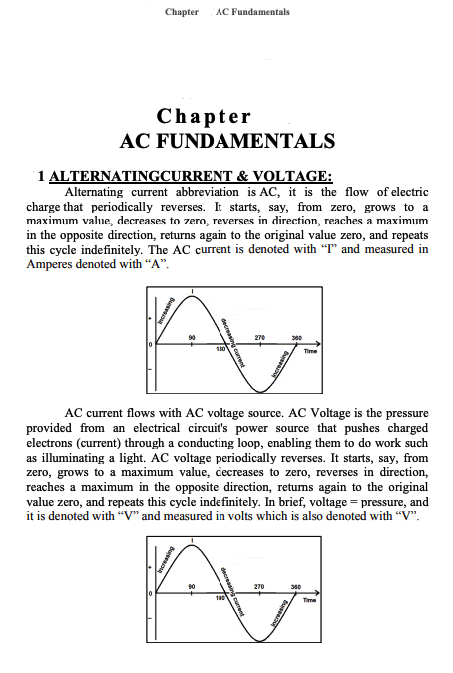Chapter AC Fundamentals Notes (Grade A)
Summary:
Chapter 7 of the ET-125 Principles of Electrical Engineering textbook comprehensively explains AC fundamentals. Alternating current (AC) is the periodic reversal of electric charge flow. It starts from zero, reaches a maximum value, returns to zero, reverses direction, and repeats this cycle indefinitely. AC current is denoted as “I” and measured in Amperes (“A”). AC voltage, denoted as “V,” is the pressure provided by the power source, which pushes charged electrons through a conducting loop. Similar to AC current, AC voltage also periodically reverses.
The chapter further discusses the principle of working an AC generator, an alternator. Alternators generate sinusoidal AC voltages through electromagnetic induction. According to Faraday’s law of electromagnetic induction, an electromotive force (e.m.f.) is induced in the conductor when there is relative motion between a conductor and a magnetic field. This induced e.m.f. can be utilized to power electrical loads.
A simple loop alternator design is explained, which involves a rectangular loop armature that cuts the lines of force between the north and south poles. As the armature rotates, it generates an electrical current, and the AC output is obtained through slip rings and brushes. The relationship between armature rotation and AC output is described, highlighting the varying number of lines of force being cut at different positions. This variation results in the generation of a single-phase AC current.
Excerpt:
Chapter AC Fundamentals Notes
C h a p t e r # 7
AC FUNDAMENTALS
7.1 ALTERNATINGCURRENT & VOLTAGE:
The alternating current abbreviation is AC; it is the flow of electric charge that periodically reverses. It starts from zero, grows to a maximum value, decreases to zero, reverses, reaches a maximum in the opposite direction, returns to the original value of zero, and repeats this cycle indefinitely. The AC current is denoted with “I” and measured in Amperes denoted with “A”.
AC current flows with an AC voltage source. AC Voltage is the pressure provided by an electrical circuit’s power source that pushes charged electrons (current) through a conducting loop, enabling them to do work such
as illuminating light. AC voltage periodically reverses.


Reviews